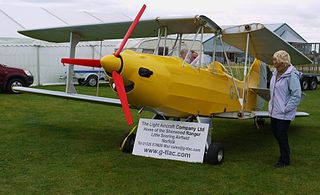
The Taylor Titch is a British fixed-wing homebuilt aircraft, developed in the 1960s by J.F. Taylor. As of 2015, examples are still being built and flown.

The Rollason Beta was a British midget racing monoplane developed from a competition to build a Formula One air racer in the 1960s in England. The Beta was first flown on 21 April 1967. The aircraft were successful air-racers in England during the late 1960s and early 1970s.

The de Havilland DH.60 Moth is a 1920s British two-seat touring and training aircraft that was developed into a series of aircraft by the de Havilland Aircraft Company.

The Jodel D.11 is a French two-seat monoplane designed and developed by Société Avions Jodel in response to a French government request for a low-wing aircraft for use by the nation's many emerging flying clubs.

The Evans VP-1 Volksplane is an American designed aircraft for amateur construction. The aircraft was designed by former Convair, Ryan Aircraft and General Dynamics aeronautical engineer William Samuel Evans of La Jolla, California.

The Luton L.A.4 Minor was a 1930s British single-seat high-wing ultra-light aircraft. The prototype was built by the Luton Aircraft Limited, and design plans were later adapted and copies sold for homebuilding.

The CAB GY-20 Minicab is a two-seat light aircraft designed by Yves Gardan and built in France by Construction Aeronautiques du Bearn (CAB) in the years immediately following World War II. CAB was formed in 1948 by Yves Gardan, Max Lapoerte and M. Dubouts.

The Jodel D.9 Bébé is a French single-seat ultralight monoplane designed by Jean Délémontez for amateur construction.

The Clutton-Tabenor FRED is a British homebuilt aircraft design introduced in 1963.

The Miles M.7 Nighthawk was a 1930s British training and communications monoplane designed by Miles Aircraft Limited.

The Piel CP-30 Emeraude is an aircraft designed in France in the mid-1950s and widely built both by factories and homebuilders.

The Druine D.60 Condor is a light aircraft designed by Roger Druine in France in the 1950s. Druine’s primary aim was to design a trainer aircraft for amateur construction. The Condor was subsequently made in quantity in the UK by Rollason Aircraft & Engines.

The Isaacs Fury is a British homebuilt sporting biplane designed by John Isaacs as a seven-tenths scale replica of the Hawker Fury fighter.
Rollason Aircraft and Engines Limited was a British aircraft manufacturer and aircraft maintenance and refurbishment company from its formation in 1957.
The Pazmany PL-4A is a single-seat, single-engine sport aircraft developed in the United States and first flown in 1972. It is marketed for homebuilding from plans, and 686 sets had sold by 1985. The PL-4A is a conventional, low-wing cantilever monoplane with an enclosed cabin and fixed, tailwheel undercarriage. The design features a T-tail, chosen to facilitate folding the wings. Construction throughout is of metal, using standard extruded sections for the longerons and pop rivets as the basic fastener. The standard powerplant is a Volkswagen air-cooled engine of 60 hp (45 kW) Construction time is estimated to be around 1,000–1,500 hours.
Chilton Aircraft Ltd was a British aircraft design and manufacturing company of the late 1930s and 1940s.

The Granger Archaeopteryx is a British single-engined, tailless parasol monoplane designed and built in the late 1920s by two brothers, R.F.T. and R.J.T. Granger. The sole example built is currently under restoration for flight.

The SAN Jodel D.140 Mousquetaire (Musketeer) is a French five-seat light touring monoplane based on the earlier Jodel D.117 and built by Société Aéronautique Normande (SAN) at Bernay.

The Preceptor N3 Pup is a family of ultralight, tube-and-fabric, high-wing, homebuilt aircraft. Kits were produced and marketed by Preceptor Aircraft, of Rutherfordton, North Carolina. The company was operating on a limited basis, actively selling plans online, but seems to have gone out of business in 2016.

The Tiger Cub Developments (TCD) Sherwood Ranger is a single engine, tandem two seat biplane microlight designed and built in the United Kingdom in the early 1990s. Kits were originally produced by TCD; later, design rights were acquired by The Light Aircraft Company Ltd (TLAC) who resumed kit production in 2009.


















